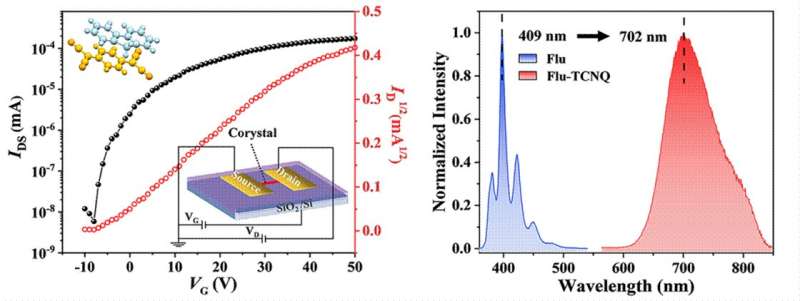Flu-TCNQ cocrystal with integrated n-type charge transport and red emission properties. Credit: Mengjia Jiang, Shuyu Li, Chun Zhen, Lingsong Wang, Fei Li, Yihan Zhang, Weibing Dong, Xiaotao Zhang, Wenping Hu
Cocrystal engineering is a strategy for assembling organic molecules via the non-covalent interaction force, avoiding harsh experimental conditions (i.e., high temperature and high pressure). By selecting the appropriate components, the donor-acceptor (D-A) molecules can be assembled like the jigsaw puzzle. Under the intermolecular interaction, such as π–π interactions, hydrogen bonds, and halogen bonds, cocrystal can not only display the intrinsic properties of its components but also show some novel properties, which can realize the "1+1>2" effect. So cocrystal strategy has the advantage in designing multifunctional materials.
Researchers led by Prof. Xiaotao Zhang at Tianjin University, China, are designing a multifunctional organic cocrystal material. They obtained a Flu-TCNQ cocrystal with integrated optoelectronic properties, which is scarce because of the contradiction between the luminescent and electric properties of organic material. Many researchers have achieved the integration of photoelectric characteristics by introducing specific functional structures, but it is time-consuming and difficult to balance the two properties. In addition, most of the organic optoelectronic materials obtained by this method exhibit a blue or green emission, and few materials exhibit red emission. And these optoelectronic materials mainly display p-type charge transport behavior.
Zhang et al. selected the Flu (donor) as the luminescence unit due to its good luminescence, extended π-conjugated plans, and rich electrons properties. And they selected the TCNQ (acceptor) as the electrical building block, a typical n-type semiconductor that can provide a strong electron-withdrawing capacity. Both compositions were easily obtained, avoiding the tedious synthetic routes. Driven by the charge transfer (CT) interaction and affected by the D-A molecules stacking mode, the emission of Flu-TCNQ cocrystal was regulated to be red, and the n-type charge transport property of the acceptor molecule was maintained in the cocrystal. Their work provides an effective solution to the shortage of organic materials with integrated optoelectronic properties.
The work, titled "TCNQ-based organic cocrystal integrated red emission and n-type charge transport," was published in Frontiers of Optoelectronics (May 9, 2022).
More information: Mengjia Jiang et al, TCNQ-based organic cocrystal integrated red emission and n-type charge transport, Frontiers of Optoelectronics (2022). DOI: 10.1007/s12200-022-00022-7
Provided by Higher Education Press
























